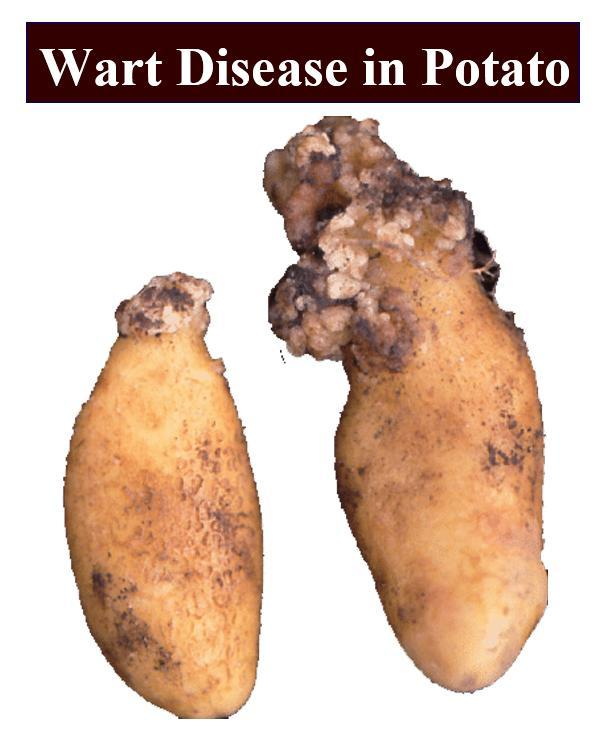
Wart disease caused by Synchytrium endobioticum occurs in:
(a) Cabbage
(b) Pea
(c) Groundnut
(d) Potato
Answer
476.7k+ views
Hint: Synchytrium endobioticum is a fungus that affects a major portion of the underground parts namely roots or tuber plant (with modified underground stem). Abnormal growth begins to happen from the bud on stems leading to the formation of warts.
Complete step by step answer:
The Wart disease caused by Synchytrium endobioticum occurs in Potato (Solanum tuberosum). The fungus was first identified and studied by Vera Charles.
Morphology: Synchytrium endobioticum has no mycelium. The fungus has a thick-walled structure known as the winter sporangium. The diameter of the fungus is about $25 \ \mu m - 75 \ \mu m$ and contains 200-300 spores. Sporangia (in which spores are formed) are clustered into a thin-walled structure known as sorus. At the motile life stage, zoospore is about $0.5 \ \mu m$ in diameter and has one flagellum at its posterior side.

Life cycle: During the spring season, at higher temperatures and moisture, overwintering sporangia germinate to release mobile zoospores. The zoospores then infect suitable host epidermal cells. In infected cells, the sporangia develop and quickly release more zoospores. The infection cycle may be repeated as long as infection conditions are suitable for the fungus. The plant cells which are infected, swell up, divide and surround the dividing zoospores of the fungus resulting in the wart.
Under the stressful condition, some zoospore pairs fuse, to form a zygote. The zygote which bears the host cells divides to form walls of a new sporangium of the winter season. In autumn, warts rot and disintegrate to release new thick-walled resting spores of the fungus into the soil bed. The resting spores undergo a period of dormancy and several mitotic divisions, becoming a sorus. The sorus later on germinates.
So, the correct answer is, ‘Potato.’
Note: Synchytrium endobioticum is an obligate parasite that infects several genera of Solanum. The most favorable conditions for its development are warm type climate (temperature not more than $20^\circ \ C$) with enough humidity. Sporangia formed in winter can remain viable for up to 20–30 years and can survive at depths of 50 cm in the soil.
Complete step by step answer:
The Wart disease caused by Synchytrium endobioticum occurs in Potato (Solanum tuberosum). The fungus was first identified and studied by Vera Charles.
Morphology: Synchytrium endobioticum has no mycelium. The fungus has a thick-walled structure known as the winter sporangium. The diameter of the fungus is about $25 \ \mu m - 75 \ \mu m$ and contains 200-300 spores. Sporangia (in which spores are formed) are clustered into a thin-walled structure known as sorus. At the motile life stage, zoospore is about $0.5 \ \mu m$ in diameter and has one flagellum at its posterior side.

Life cycle: During the spring season, at higher temperatures and moisture, overwintering sporangia germinate to release mobile zoospores. The zoospores then infect suitable host epidermal cells. In infected cells, the sporangia develop and quickly release more zoospores. The infection cycle may be repeated as long as infection conditions are suitable for the fungus. The plant cells which are infected, swell up, divide and surround the dividing zoospores of the fungus resulting in the wart.
Under the stressful condition, some zoospore pairs fuse, to form a zygote. The zygote which bears the host cells divides to form walls of a new sporangium of the winter season. In autumn, warts rot and disintegrate to release new thick-walled resting spores of the fungus into the soil bed. The resting spores undergo a period of dormancy and several mitotic divisions, becoming a sorus. The sorus later on germinates.
So, the correct answer is, ‘Potato.’
Note: Synchytrium endobioticum is an obligate parasite that infects several genera of Solanum. The most favorable conditions for its development are warm type climate (temperature not more than $20^\circ \ C$) with enough humidity. Sporangia formed in winter can remain viable for up to 20–30 years and can survive at depths of 50 cm in the soil.
Recently Updated Pages
Master Class 11 Economics: Engaging Questions & Answers for Success

Master Class 11 Business Studies: Engaging Questions & Answers for Success

Master Class 11 Accountancy: Engaging Questions & Answers for Success

The correct geometry and hybridization for XeF4 are class 11 chemistry CBSE

Water softening by Clarks process uses ACalcium bicarbonate class 11 chemistry CBSE

With reference to graphite and diamond which of the class 11 chemistry CBSE

Trending doubts
What are the elders in Goa nostalgic about class 11 social science CBSE

Formaldehyde at room temperature is ALiquid BGas CSolid class 11 chemistry CBSE

Define least count of vernier callipers How do you class 11 physics CBSE

Distinguish between Mitosis and Meiosis class 11 biology CBSE

Why are forests affected by wars class 11 social science CBSE

Explain zero factorial class 11 maths CBSE




